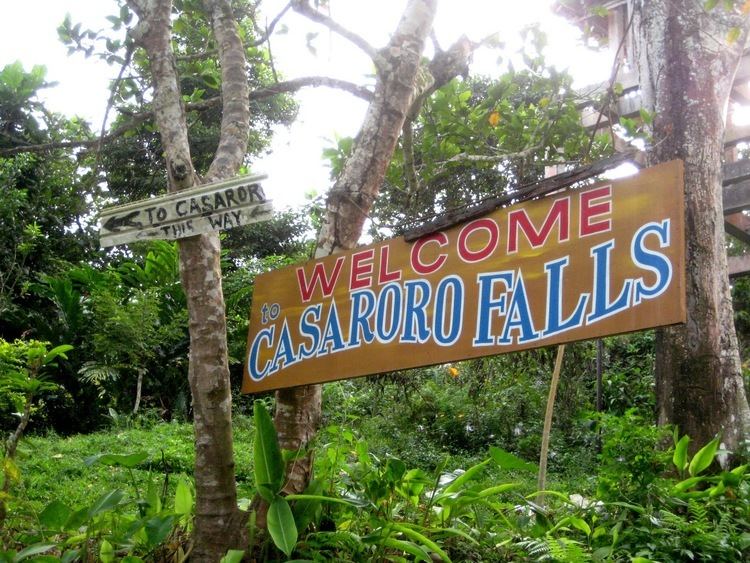Barangays ZIP code 6215 | Time zone PST (UTC+8) Population 60,000 (2015) | |
 | ||
Weather 24°C, Wind NE at 11 km/h, 95% Humidity Points of interest Casaroro Falls, Pulangbato Falls Valencia, Mount Talinis, Lake Nailig, Lake Yagumyum | ||
Valencia is a first class municipality in the province of Negros Oriental, Philippines. It is located 9 kilometres (5.6 mi) west of Dumaguete City, the largest city and capital of the province. According to the national 2015 census, it has a population of 34,852 people. The municipality was voted as "the greenest and cleanest" town of Negros Oriental in 2007. The mayor of Valencia is Edgar Teves, who was elected in 2013.
Contents
- Map of Valencia Negros Oriental Philippines
- Geography
- Barangays
- History
- Demographics
- Economy
- Attractions
- Public Elementary Schools
- List of former mayors
- References
Map of Valencia, Negros Oriental, Philippines
Our Lady of the Abandoned is the patroness of Valencia, and her feast day is celebrated annually every October 12 with the town fiesta. The fiesta is an official non-working holiday for the town.
Geography
Valencia occupies an area of 14,749 hectares (36,450 acres), 35% of which are classified as plains. The town is 65% mountainous, with elevation averaging from 200 to 500 metres (660 to 1,640 ft) above sea level, with the top of Mount Talinis at an elevation of 1,903 metres (6,243 ft) along the municipal southern boundary. The climate in the municipality is relatively cool, especially at higher elevations.
The region is also the most critical watershed area of Negros Oriental, providing abundant drinking water to Valencia and its neighboring municipalities.
Barangays
The town is politically subdivided into 24 barangays.
History
Valencia was originally named Ermita, which means "a secluded place", due to its being a refuge from marauding Muslim pirates. In 1856 it was renamed to Nueva Valencia by Spanish colonizers, in honor of its parish priest Fr. Matias Villamayor from Valencia, Spain.
In 1920 it was renamed Luzuriaga (also spelled Luzurriaga) in honour of Don Carlos Luzuriaga, a delegate from Negros island to the Philippine Legislature who promised town officials he would work hard to help improve the town. The town was renamed Valencia in 1948, by virtue of Republic Act No. 252.
During World War II, Malabo was the headquarters of the Free Government and resistance movement in Negros Oriental.
In 2007, its Municipal Police Station (under the Negros Oriental Provincial Police Office (NOPPO) headed by Senior Supt. Melvin Ramon Buenafe) was adjudged the “Municipal Police Station of 2007” in the best unit awards category, and the best town police station in the Central Visayas (General order no. 110 dated January 22, 2008).
Demographics
The Cebuano language is the common vernacular in Valencia. Hiligaynon, Tagalog, and English are also widely spoken.
Economy
The economy of Valencia is largely based on agriculture. Major products include abaca, copra, corn, flowers, vegetables, root crops, and exotic fruits such as lanzones and rambutan.
The municipality is also the site of a geothermal power station operated by the Energy Development Corporation. It generates electricity that supplies the needs of Negros, Panay, and part of Cebu. The municipal government receives royalties from the power station.
Valencia, specifically, has a 20-megawatt Palinpinon 2 Geothermal Optimization Project in Sitio Nasuji, Barangay Puhagan, 35 kilometers from Dumaguete City. The P 1.74-billion geothermal optimization (expansion) project, funded the Development Bank of the Philippines (DBP) is part of EDC's 192-MW Southern Negros Geothermal Production Field that supplies the power needs of 8 provinces in Negros, Panay, Guimaras and Cebu Islands. Valencia's 192-MW Palinpinon I and II geothermal field ranks 4th in installed capacity nationwide. The Palinpinon field contributed $457.8 million in 2004 foreign exchange savings for 2004, and also generated $267 million savings from January to July, 2008.
Because Palinpinon is such a big source of geothermal energy, Gloria Macapagal-Arroyo said it received P 250 million in royalties, applied for livelihood, education, related projects, and also for the 50% subsidy on Valencia electric bills consumers. Many residents also work in the nearby city of Dumaguete.
Attractions
The Filipino-Japanese Amity Memorial Shrine is located in Valencia. It stands at the foot of Mount Talinis and marks the spot where the combined Filipino and American troops including the Negrosanon guerrilla units fought the Japanese Imperial Army toward the end of World War II.
Eco-tourism sites include:
